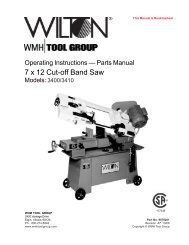This Rigger's Handbook is dedicated to Theodore C - Igor Chudov
This Rigger's Handbook is dedicated to Theodore C - Igor Chudov
This Rigger's Handbook is dedicated to Theodore C - Igor Chudov
You also want an ePaper? Increase the reach of your titles
YUMPU automatically turns print PDFs into web optimized ePapers that Google loves.
YOUR SLING AND RIGGING SPECIALIST<br />
WIRE ROPE ABUSE continued<br />
Wire rope left on machines shut down for<br />
long periods of time deteriorates rapidly. To<br />
preserve the rope for future sue, it should<br />
be removed, cleaned and thoroughly<br />
lubricated.<br />
CAUSES OF CORROSION DAMAGE<br />
Pitting, erosion and surface effects of many<br />
different types can all result in corrosion<br />
damage. Because they tend <strong>to</strong> increase<br />
corrosion, the following conditions should<br />
be considered and noted when applicable,<br />
during the ordering of wire rope: acid and<br />
alkaline solutions, gases, fumes, brine and<br />
salt air, sulphurous compounds, and high<br />
humidity and temperature. Lubricants are<br />
readily available <strong>to</strong> reduce the severity of<br />
attack of most of these conditions.<br />
EFFECTS OF SEVERE HEAT<br />
Where wire rope <strong>is</strong> subjected <strong>to</strong> severe heat<br />
(e.g., foundry cranes) it will not give the<br />
service expected because it will deteriorate<br />
more quickly.<br />
Wire ropes exposed <strong>to</strong> hot-metal handling<br />
or other extreme heat sometimes require<br />
independent wire rope cores.<br />
SHIFTING ROPES FROM ONE JOB<br />
TO ANOTHER<br />
Sometimes an idle wire rope from one<br />
operation <strong>is</strong> installed on another <strong>to</strong> keep the<br />
rope in continuous service. <strong>Th<strong>is</strong></strong> extremely<br />
poor practice <strong>is</strong> an expensive "economy."<br />
Because wire rope tends <strong>to</strong> "set" <strong>to</strong> the<br />
conditions of its particular operating job, the<br />
differing bends, abrasions and stresses of a<br />
new operation can produce premature<br />
failure. Therefore, for a maximum life and<br />
efficiency, a rope should be used only on<br />
the job for which it has been specified.<br />
MACHINERY OPERATION<br />
Some opera<strong>to</strong>rs are harder on their<br />
machinery than others and as a result they<br />
get shorter rope life. In certain instances,<br />
enough extra work <strong>is</strong> done <strong>to</strong> more than<br />
offset the additional wear-and-tear on<br />
equipment and wire rope. The operation<br />
may be more efficient from the production<br />
standpoint as a result, but those in charge<br />
of rope purchases should be made aware of<br />
the probable reduction in rope life and<br />
increased rope costs.<br />
HEADQUARTERS: 55 James E. Casey Drive • Buffalo, NY 14206 PHONE: 716.826.2636 FAX: 716.826.4412 www.hanessupply.com<br />
129<br />
Wire Ropes<br />
REVERSE BENDING Running th<strong>is</strong> rope over one sheave and under<br />
another caused fatigue breaks in wires.<br />
EXCESSIVE EXPOSURE TO ELEMENTS. Too much exposure<br />
combined with surface wear and loss of lubrication caused corrosion<br />
and pitting.<br />
TOO LONG IN SERVICE. Repeated winding and overwinding of th<strong>is</strong><br />
rope on a drum while it was under heavy stress caused the unusually<br />
severe wear shown.<br />
UNDERSIZE SHEAVE GROOVES. Sheaves were <strong>to</strong>o small, causing<br />
strands <strong>to</strong> pinch. Wires then fail in the valley between the strands.<br />
POOR WORK PROCEDURES. Damage <strong>to</strong> strands and wires resulted<br />
from electric arcing.<br />
LACK OF KNOWLEDGE. Here's what occurs when a loop which has<br />
been "pulled through" and tightened remains in service.
















